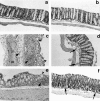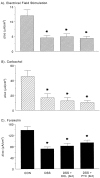Dextran sulfate sodium-induced colonic histopathology, but not altered epithelial ion transport, is reduced by inhibition of phosphodiesterase activity
- PMID: 10854237
- PMCID: PMC1850075
- DOI: 10.1016/S0002-9440(10)65087-0
Dextran sulfate sodium-induced colonic histopathology, but not altered epithelial ion transport, is reduced by inhibition of phosphodiesterase activity
Abstract
Inhibition of phosphodiesterase (PDE) activity is beneficial in models of arthritis and airway inflammation. Here we assessed the ability of PDE inhibitors to modulate colitis by exposing mice to 4% (w/v) dextran sulfate sodium (DSS) drinking water for 5 days with or without rolipram, an inhibitor of PDE type 4, or the nonselective PDE inhibitor, pentoxifylline (both at 5 mg/kg, i.p., twice daily). Controls received saline, vehicle, or drug only. Colonic histology, myeloperoxidase (MPO) and tumor necrosis factor-alpha (TNF-alpha) levels, and epithelial ion transport (baseline and stimulated by electrical nerve stimulation, carbachol, and forskolin) were examined. DSS-treated mice displayed a variable diarrhea, significant histopathology in the mid-distal colon, elevated MPO activity, and reduced (>50%) responses to all three pro-secretory stimuli. Treatment with rolipram, and to a lesser extent pentoxifylline, significantly reduced the severity of the colonic histopathology and MPO levels. Neither PDE inhibitor had any affect on the diminished ion transport events caused by DSS-induced colitis. However, although stimulated ion transport events were still reduced 3 days after DSS treatment, colonic segments from DSS + rolipram-treated mice displayed enhanced recovery in their secretory responsiveness, particularly to carbachol. These findings indicate that specific PDE4 inhibition can significantly reduce the tissue damage that accompanies colitis and enhance recovery of normal colonic function.
Figures





References
-
- Torphy TJ: Phosphodiesterase isozymes. Molecular targets for novel anti-asthma agents. Am J Respir Crit Care Med 1998, 157:351-370 - PubMed
-
- Doherty AM: Phosphodiesterase 4 inhibitors as novel anti-inflammatory agents. Curr Opin Chem Biol 1999, 3:466-473 - PubMed
-
- Teixeira MM, Gristwood RW, Cooper N, Hellewell PG: Phosphodiesterase (PDE) 4 inhibitors: anti-inflammatory drugs of the future? Trends Pharmacol Sci 1997, 18:164-171 - PubMed
-
- Klemm P, Harris HJ, Perretti M: Effect of rolipram in a murine model of acute inflammation: comparison with the corticoid dexamethasone. Eur J Pharmacol 1995, 281:69-74 - PubMed
Publication types
MeSH terms
Substances
LinkOut - more resources
Full Text Sources
Other Literature Sources
Molecular Biology Databases
Research Materials
Miscellaneous

